AMD Carrizo Part 2: A Generational Deep Dive into the Athlon X4 845 at $70
by Ian Cutress on July 14, 2016 9:00 AM ESTStock Comparison: Linux Performance
Built around several freely available benchmarks for Linux, Linux-Bench is a project spearheaded by Patrick at ServeTheHome to streamline about a dozen of these tests in a single neat package run via a set of three commands using an Ubuntu 11.04 LiveCD. These tests include fluid dynamics used by NASA, ray-tracing, OpenSSL, molecular modeling, and a scalable data structure server for web deployments. We run Linux-Bench and have chosen to report a select few of the tests that rely on CPU and DRAM speed.
All of our benchmark results can also be found in our benchmark engine, Bench.
C-Ray: link
C-Ray is a simple ray-tracing program that focuses almost exclusively on processor performance rather than DRAM access. The test in Linux-Bench renders a heavy complex scene offering a large scalable scenario.
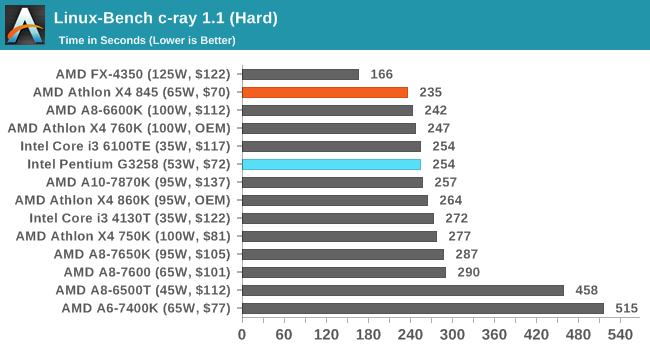
When we push up to full speed, the X4 845 comes alive and beats all the other Athlon CPUs (which wasn't the case at 3 GHz). It also pushes above the Pentium.
NAMD, Scalable Molecular Dynamics: link
Developed by the Theoretical and Computational Biophysics Group at the University of Illinois at Urbana-Champaign, NAMD is a set of parallel molecular dynamics codes for extreme parallelization up to and beyond 200,000 cores. The reference paper detailing NAMD has over 4000 citations, and our testing runs a small simulation where the calculation steps per unit time is the output vector.
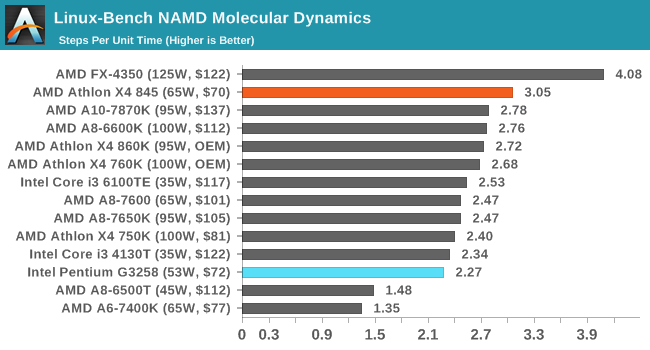
Similar things happen with NAMD.
NPB, Fluid Dynamics: link
Aside from LINPACK, there are many other ways to benchmark supercomputers in terms of how effective they are for various types of mathematical processes. The NAS Parallel Benchmarks (NPB) are a set of small programs originally designed for NASA to test their supercomputers in terms of fluid dynamics simulations, useful for airflow reactions and design.
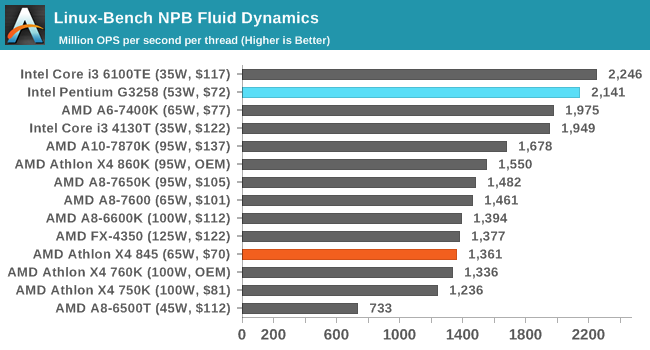
NPB seems more amenable with Intel CPUs in this case. I feel the cache arrangement in the X4 845 is the let down here again.
Redis: link
Many of the online applications rely on key-value caches and data structure servers to operate. Redis is an open-source, scalable web technology with a strong developer base, but also relies heavily on memory bandwidth as well as CPU performance.
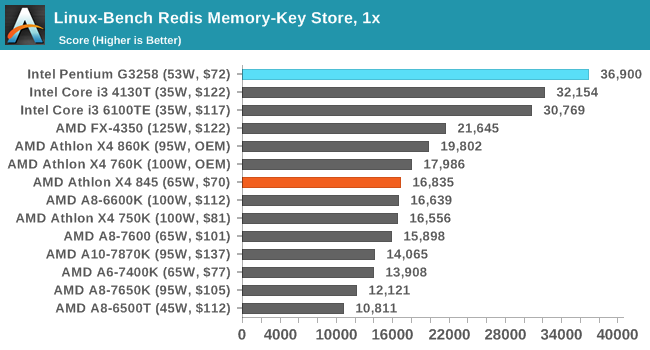
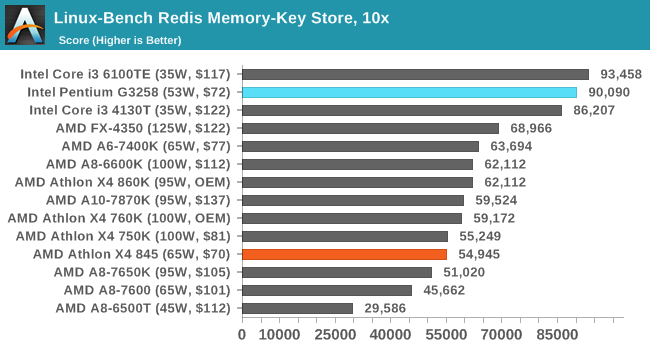
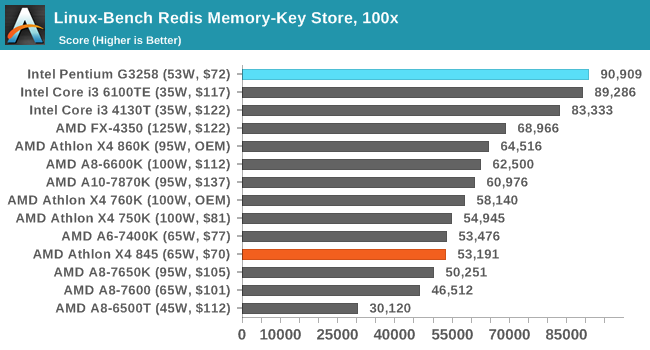
Redis easily favors high speed caches, and the Pentium oozes performance in this case.










131 Comments
View All Comments
Peichen - Thursday, July 14, 2016 - link
I stopped reading at the messy chart where Athlon X4 750 is available from 2 µArch and there is no science to naming. AMD's CPU division was a bigger failure than its GPU division and it still it. I used to have 3 AMD systems at the same time back in 2005 but have steadily moved away and was considering replacing the last AMD system (Phenom II 840) using Prime Day sales.Ian Cutress - Thursday, July 14, 2016 - link
The 750 and 750K are two different SKUs. As mentioned, trying to find the 750 at retail (and in stock) is *really difficult*, and I'd probably point to it being an OEM-only SKU for a certain design. If anyone has a 750/can find one, let me know.artk2219 - Wednesday, July 20, 2016 - link
I found a link for one, but I think its just an OEM one, and it's from Aliexpress, so it may take a while to get to you. I hope I could help!http://www.aliexpress.com/item/AMD-Athlon-X4-750-A...
http://www.cpu-world.com/CPUs/Bulldozer/AMD-Athlon...
jefeweiss - Thursday, July 14, 2016 - link
I don't think poignant is the word you are looking for here. That would be something that makes you very sad, or emotionally touches you deeply.wallysb01 - Thursday, July 14, 2016 - link
I guess I don't totally understand the comparison to the G3258. I know its a fairly popular processor (I have its non-overclockable little brother, the G3250, and love it in a simple home office set up that I use occasionally for light gaming too). However, its 2 years old. Where is the G4500 or G4520? Supposedly the skylake Pentium would be about 10% faster than haswell, no? And with some perf/W gains too?Speaking of which, where's the comparison to Intel in the power consumption? Do I just not want to see that? If in these multithreaded tasks the 845 is chugging along using 80-85 W, while the Intel parts are still near their stated TDP, it more or less invalidates the small performance gain of the AMD chip in those tasks. Looking back at the skylake review, it seems at load the Intel chips might be using anything from 0-20% more than their TDP, this AMD chip is going 30% above.
I'd love it if AMD could push intel into offering more cores at lower price points, but this doesn't seem good enough to do that....
stardude82 - Thursday, July 14, 2016 - link
Tacking on a G4500 is not terribly pertinent to the task at hand and they are just using archived results here. The comparison from the 2 i3 parts should give you an idea of relative performance. Otherwise, I'm surprised we get such an in depth review from an hollowed out Anandtech.You are confusing TDP with total system draw.
You have a "four core" CPU here for $70, what more do you want? They soundly thrash the dual-core Pentiums and i3s in some well parallelized applications. The problem is the world isn't well parallelized and the CPUs don't have 4 real cores which is why you have i3s still competitive 8 core FX chips.
yannigr2 - Thursday, July 14, 2016 - link
WOW. This is an amazing work. It does explain too much about AMD's Bulldozer versions. It does explain why AMD doesn't bother to bring the full Carrizo line in desktop. It does show, at least from my perspective, that Bulldozer architecture was not a bad architecture to begin with, but a dead end from the beginning.artk2219 - Thursday, July 14, 2016 - link
Sigh, poor Llano and your FM1 package, always forgotten. Granted it was the last of the stars cores, and not a bulldozer derivative, but it would still be nice to see it included with its brethren.TheinsanegamerN - Thursday, July 14, 2016 - link
The last of AMD's good cores. Mobile Llano was fantastic for OCing and undervolting.artk2219 - Thursday, July 14, 2016 - link
Indeed it was/is, my fiance is still using my old Asus K53TA. I overclocked the A6 (back when A6's came with 4 cores) in that laptop to run at 2.4 instead of 1.4 for the base, and the turbo to 3Ghz. while overclocking i was able to undervolt at base clocks, and slightly overvolt the turbo clocks. In effect I got better battery life and waaayyyy better performance by just spending a little time playing with the P-States. I still think thats one of the best laptops I've ever owned in terms of reliability and capability, if only it weren't so clunky. Sigh, well you cant have it all.http://www.newegg.com/Product/Product.aspx?Item=N8...